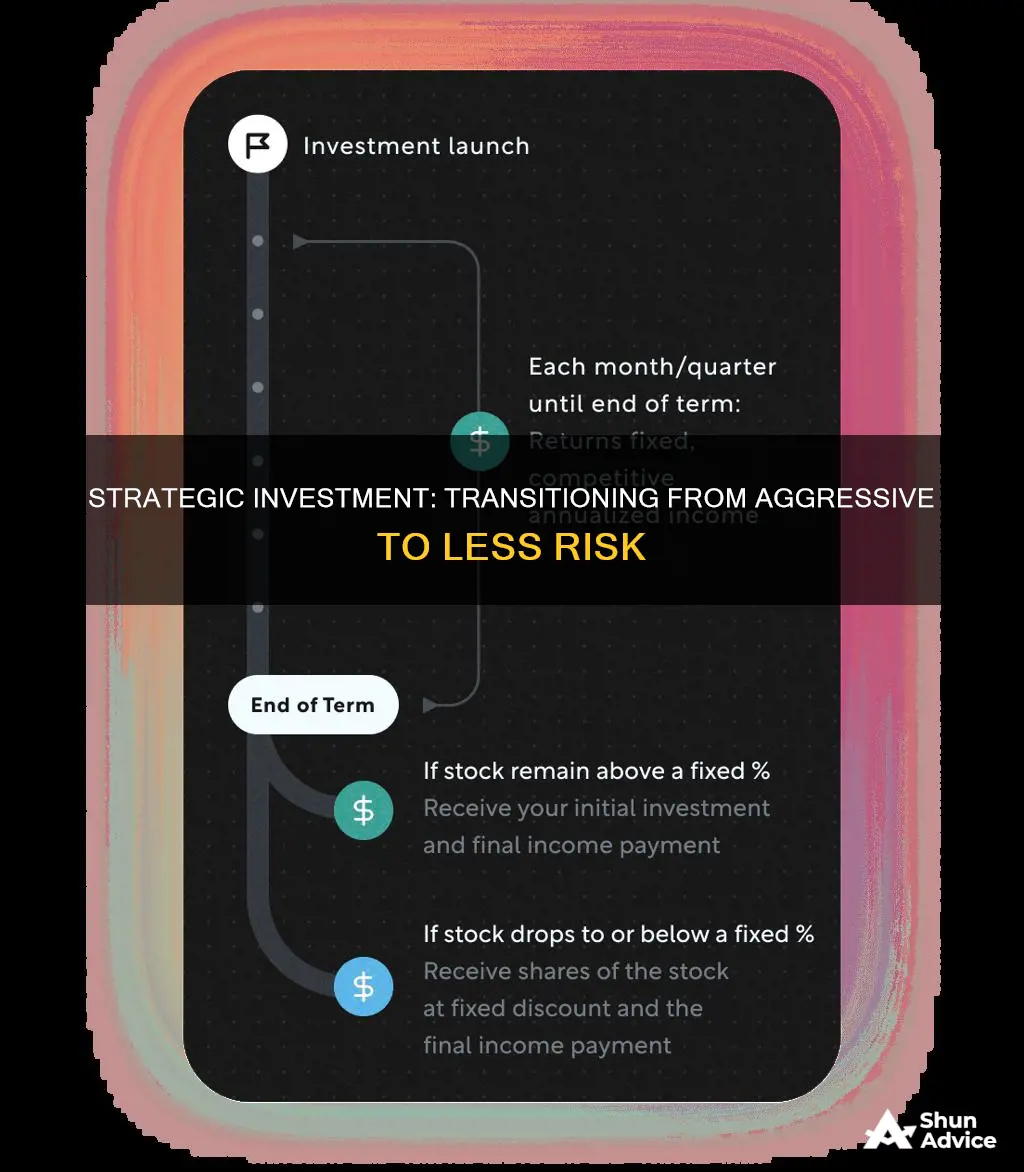
An aggressive investment strategy is a style of portfolio management that attempts to maximise returns by taking a relatively higher degree of risk. This strategy is typically suitable for young adults with smaller portfolio sizes, as they are more likely to be able to ride out market fluctuations and recover from losses. However, as investors get closer to retirement, they may want to transition to a more conservative portfolio to preserve their capital and seek guaranteed returns. The decision to transition from aggressive to less risky investments depends on an investor's goals, timeline, and risk tolerance.
| Characteristics | Values |
|---|---|
| Market sentiment | During a bull market, investors may be more willing to take on higher-risk investments. During a bear market, investors may shift towards safer investments. |
| Investor age | Aggressive investment strategies are typically recommended for young adults with smaller portfolios. |
| Investment goals | Aggressive investors tend to have a higher risk tolerance and are willing to risk more money for potentially better returns. Conservative investors tend to have a lower risk tolerance and seek guaranteed returns. |
| Investment timeline | Aggressive investment portfolios are generally more suitable for investors with a longer investment horizon, as they can ride out market fluctuations. |
| Income | An investor's income contributes to their risk tolerance. |
What You'll Learn

Bull and bear markets
A bull market is characterised by rising stock prices and economic optimism. In this environment, investors may be more willing to take on higher-risk investments, expecting continued growth and profitability. Positive market sentiment can boost confidence and risk tolerance, leading to more aggressive investment positions.
Bull markets are often associated with aggressive investment strategies, which typically involve a higher degree of risk to maximise returns. These strategies emphasise capital appreciation over income or safety, with a substantial weighting in stocks and little to no allocation to bonds or cash. Aggressive strategies are usually recommended for young adults with smaller portfolios, as they have a longer investment horizon to ride out market fluctuations and early career losses have less impact.
However, during bear markets, investors' risk tolerance tends to decrease. Bear markets are characterised by falling prices and pessimistic market sentiment, which can lead investors to prioritise capital preservation over high returns. Investors may shift towards safer investments, such as Treasury bills or certificates of deposit, seeking low-risk options that offer steady, albeit modest, returns.
A less risky but still aggressive portfolio may focus on blue-chip stocks, which are known for their ability to weather market conditions over the long term. Alternatively, a balanced portfolio combines conservative and aggressive investments to hedge against volatility, typically involving a mix of stocks and bonds. This approach aims to balance risk while capturing the highest return potential based on an acceptable level of risk.
The decision to transition from aggressive to less risky investments depends on various factors, including age, investment goals, and income. Aggressive investors typically have a higher risk tolerance and are willing to take on more risk for potentially better returns, while conservative investors seek guaranteed returns and have a lower risk tolerance. It's important for investors to assess their risk tolerance and determine an acceptable level of risk based on their goals and circumstances.
Maximizing Returns: Strategies to Achieve 400% Investment Growth
You may want to see also

Risk tolerance
On the other hand, conservative investors have a lower risk tolerance and seek investments with guaranteed returns. They may prioritise capital preservation over high returns, especially if they are retired or nearing retirement. Conservative portfolios often include a combination of stocks and bonds to balance risk and volatility.
An investor's risk tolerance can also be influenced by market conditions. In a bull market, characterised by rising stock prices and economic optimism, investors may feel more confident and be more willing to take on risk. However, during bear markets, when prices are falling and market sentiment is pessimistic, investors' risk tolerance may decrease. The fear of further losses may lead them to shift towards safer investments, such as Treasury bills or certificates of deposit.
It is important for investors to assess their risk tolerance regularly, as it can change over time due to various factors, including age, financial situation, and market conditions. By understanding their risk tolerance, investors can make informed decisions about their portfolio allocation and choose investments that align with their goals and comfort level.
Lindsell Train Global Equity: Worth Your Investment?
You may want to see also

Age and income
Age plays a significant role in determining an investor's risk appetite. Generally, younger adults with smaller portfolio sizes are considered better suited for aggressive investment strategies. This is because they have a longer investment horizon, allowing them to weather market fluctuations and recover from potential losses early in their careers. As investors approach retirement age, transitioning to a conservative portfolio becomes more prudent. Retirement funds are often an investor's sole source of income during their golden years, making capital preservation a priority over high returns.
Income is another critical factor in investment decisions. Aggressive investors typically have a higher risk tolerance and are willing to risk more capital in pursuit of potentially higher returns. They are comfortable with the possibility of losses in exchange for the prospect of overall higher gains. On the other hand, conservative investors usually have a lower risk tolerance and seek investments with guaranteed returns. They prioritise income stability and safety of principal over aggressive growth strategies.
The transition from aggressive to less risky investments depends on an individual's financial goals, risk tolerance, and life stage. As investors mature and their financial responsibilities evolve, they may opt for a more balanced portfolio that combines conservative and aggressive investments. This approach helps strike a balance between risk and return, providing stability and growth potential.
Additionally, market conditions can influence the timing of the transition. During bull markets, characterised by rising stock prices and economic optimism, investors may feel more inclined to take on riskier investments, expecting continued growth. Conversely, during bear markets, marked by falling prices and pessimism, risk tolerance may decrease. Investors may shift towards safer investments, such as Treasury bills or certificates of deposit, prioritising capital preservation and steady, albeit modest, returns.
Fidelity's Investment Management: Is It Right for You?
You may want to see also

Conservative portfolios
A conservative portfolio can help investors balance their risk exposure, especially if they are concerned about potential losses during bear markets. By prioritising capital preservation, conservative portfolios aim to protect an investor's principal while still generating modest returns. This approach may be less ideal for investors with a longer time horizon who are willing to take on more risk in exchange for potentially higher returns.
The transition from aggressive to conservative investments often depends on an investor's goals, timeline, and risk tolerance. As investors approach retirement, they may shift towards a more conservative portfolio to ensure their savings are protected. This transition can also be influenced by market conditions, with investors becoming more conservative during bear markets to minimise potential losses.
A conservative portfolio can provide stability and peace of mind for investors who are risk-averse or have a shorter investment horizon. It is important for investors to assess their risk tolerance and investment goals regularly to determine if a conservative portfolio aligns with their financial objectives. Risk tolerance assessments are available online and can help investors understand their comfort level with risk, guiding their investment decisions.
Building a Tax-Efficient Investment Portfolio: Strategies for Success
You may want to see also

Balanced portfolios
A balanced portfolio is a combination of conservative and aggressive investments. The goal is to balance risk and return potential, hedging against volatility. This typically involves investing in a combination of stocks and bonds.
A balanced portfolio is suitable for investors who want to take advantage of the potential for higher returns in a strong market while also protecting themselves from significant losses in a weak market. This strategy is often recommended for investors with a moderate risk tolerance.
The specific mix of conservative and aggressive investments in a balanced portfolio will depend on the investor's goals, risk tolerance, and time horizon. For example, a young investor with a long time horizon might be comfortable with a higher allocation to aggressive investments, as they can afford to ride out market fluctuations. On the other hand, an investor nearing retirement might prefer a more conservative mix, prioritising capital preservation over high returns.
When transitioning from aggressive to less risky investments, it's important to consider the overall market conditions and your own financial situation. In a bull market, characterised by rising stock prices and economic optimism, you might be more willing to invest in higher-risk assets. During bear markets, your risk tolerance might decrease, and you may shift towards safer investments such as Treasury bills or certificates of deposit.
High-Risk Investment Strategies: Maximizing Returns, Managing Risk
You may want to see also
Frequently asked questions
An aggressive investment strategy is a style of portfolio management that attempts to maximise returns by taking a relatively higher degree of risk. This strategy is typically suitable for young adults with smaller portfolio sizes, as they are more likely to be able to ride out market fluctuations and recover from losses.
A conservative investment strategy is one that has a lower risk tolerance and seeks investments with guaranteed returns. This strategy may be more suitable for retired investors or those near retirement, as they are more likely to prioritise capital preservation over high returns.
The decision to transition from an aggressive to a conservative investment strategy depends on your goals, risk tolerance, and investment timeline. If you are approaching retirement and are concerned about preserving your capital, you may want to consider transitioning to a conservative strategy. Additionally, during bear markets, your risk tolerance may decrease, and you may feel more comfortable shifting towards safer investments.







